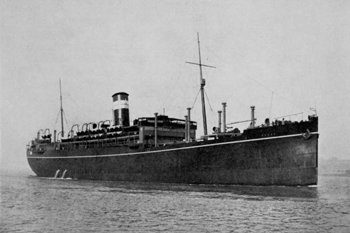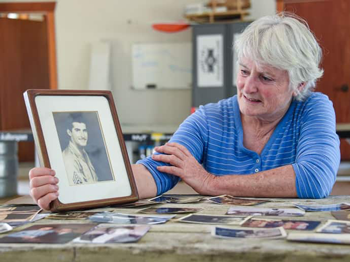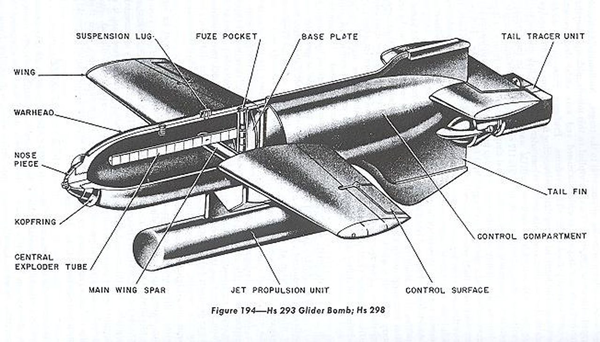The HMT Rohna: World War II’s Secret Tragedy

The HMT Rohna was sunk in 1943. The War Dept. kept its demise a secret. Information wasn’t declassified until 1995. Credit: National Archives.
Secrets, secrets, secrets! Why is it our government and other regimes simply call an incident or encounter “classified information” when they don’t want anyone to know about it? Denise Sharp, a historian from Brookeville, Maryland, says, “Their secrets are difficult to unravel unless you have the determination to follow every little clue that might lead to a cover-up.” That’s exactly what she did when discovering that the U.S. government and its military had hushed up the sinking of a transport ship during WWII. The HMT Rohna, a passenger/cargo vessel converted to a troop ship in 1940, was sunk by the Germans on November 25, 1943. Blurbs about the incident appeared in a few newspapers, but for reasons unknown, no details were released. Except for the loved ones of the l,115 troops and crew who were killed, most people viewed the tragedy as just another one of the thousands of Allied ships sunk during the war.

Mrs. Denise Sharp shows a photo of her father whose story encouraged her to unearth more facts about the tragedy. Credit: Baltimore Sun.
Mrs. Sharp’s father, Donald Doerer, fought in Europe during WWI, but seldom spoke about it. He closely followed the events of WWII and told her about visiting the mother of a friend who was missing in action. “She was devastated,” Mrs. Sharp recalls. “My father said she cried and cried and revealed that the only response she received from the military was a terse telegram sent six months after the battle at sea informing her of “the loss of her son when his ship was sunk by the enemy.” U.S. Army Air Force Sgt. Earl V. Hahn Jr., from Baltimore, was listed in the losses when his ship went down off the coast of Algeria after being hit by a bomb dropped from a German airplane.
As Mrs. Sharp dug deeper into the story, which was fast becoming a cover-up, she took all the little threads and wove them into a complete tale.
The British India Steamship Company built the SS Rohna as a combined passenger and cargo ship in the 1920s. Once the war broke out, the British government commandeered it, renamed it HMT (His Majesty’s Transport) Rohna and painted it black. Pressed into service as a troop transfer ship, it could carry as many as 2,000 very cramped soldiers. The Rohna and four other troop ships left Oran, French Algeria, on Thanksgiving Day, 1943, destination… the Suez Canal. It soon joined a convoy making its way from the UK to Alexandria, Egypt, Northeast Africa. As the ships passed through “Suicide Alley,” a dangerous Mediterranean Sea Strait, sure enough along came two dozen German heavy bombers and light aircraft flying from the West with the sun behind them. But the enemy faced fierce opposition. That’s why ships sail in a convoy, this one protected by the Free French Air Force and British Spitfires.
 Sailors in the convoy cheered as the enemy planes departed not having made a “kill” during the sudden attack. But seeing is believing and it was hard to comprehend what happened next. As a Luftwaffe aircraft, one of Herman Goring’s Strategic Air Command bombers left the scene, an object flew out of it, made a 90 degree turn and bore in on the Rohna. Our navy later learned it was an HS-293, a cutting edge “glide bomb” that could change direction and track its target at 500 miles an hour. Radio operated, it was the forerunner to our present day guided missiles.
Sailors in the convoy cheered as the enemy planes departed not having made a “kill” during the sudden attack. But seeing is believing and it was hard to comprehend what happened next. As a Luftwaffe aircraft, one of Herman Goring’s Strategic Air Command bombers left the scene, an object flew out of it, made a 90 degree turn and bore in on the Rohna. Our navy later learned it was an HS-293, a cutting edge “glide bomb” that could change direction and track its target at 500 miles an hour. Radio operated, it was the forerunner to our present day guided missiles.
As it struck the ship’s waterline, the bomb tore a hole through both sides of the hull, exploded and killed 300 instantly. The remaining victims scrambled for the lifeboats or leaped into the water and watched their ship disappear in deep water 15 miles north of Tunisia. It sank within 90 minutes of the attack. Seventy of the survivors were rescued by the destroyer HMT Atherstone, while other ships picked up over 800 others from the water or lifeboats. The losses came from the explosion or drowning. The attack was the largest loss of U.S. troops at sea due to enemy action in a single encounter. It also marked the first successful deployment of a “smart bomb” against U.S forces. The War Department swore the survivors to secrecy under threat of court martial, which left the catastrophe all but unknown to the public for more than 50 years.

A “glide bomb,” forerunner of our present day guided missiles, tore a hole in both sides of the ship’s hull. Credit: U.S. Navy.
Historians who’ve studied the story debate why the War Department—now dubbed Department of Defense—squelched news of the attack. Some say it was a ploy to preserve morale and that people might be afraid the missile could be launched at major cities in the U.S. and UK. Others believe the British government wanted to conceal how poorly equipped the ships were to fend off a smart bomb attack. By the early 1990s, the Defense Department declassified the disaster and records became available to the public. This opened the door for Jack Ballo of Ultravision Films, a South River, New Jersey, filmmaker, to complete a documentary, “Rhona Classified,” which brings the whole story to life. Ballo says, “The film is about what happens when a frightening onslaught like this occurs, becomes classified, and the War Department doesn’t share its secret with families of the deceased. The truth gets lost and history books don’t offer any details. We’ve been working on this film for nearly three years and it’s almost finished. Our major objective is to reach out to families of victims and survivors who’ve yearned for more information for many years.” Anyone who wants information or may have had a relative or friend on the Rhona may contact Jack Ballo: Jack@ultravisionfilms.com. A You Tube trailer may be viewed at: Rohnaclassified.com.
Note: Rhona survivors and relatives have created a Survivors Military Memorial Association whose members have met in various cities almost every year since 1993.
Author: Ellsworth Boyd
Ellsworth Boyd, Professor Emeritus, College of Education, Towson University, Towson, Maryland, pursues an avocation of diving and writing. He has published articles and photo’s in every major dive magazine in the US., Canada, and half a dozen foreign countries. An authority on shipwrecks, Ellsworth has received thousands of letters and e-mails from divers throughout the world who responded to his Wreck Facts column in Sport Diver Magazine. When he’s not writing, or diving, Ellsworth appears as a featured speaker at maritime symposiums in Los Angeles, Houston, Chicago, Ft. Lauderdale, New York and Philadelphia. “Romance & Mystery: Sunken Treasures of the Lost Galleons,” is one of his most popular talks. A pioneer in the sport, Ellsworth was inducted into the International Legends of Diving in 2013.
19 Comments
Submit a Comment
All Rights Reserved © | National Underwater and Marine Agency
All Rights Reserved © | National Underwater and Marine Agency
Web Design by Floyd Dog Design
Web Design by Floyd Dog Design

Great article Mr. Boyd. All I can say is that not much has changed with respect to government secrets and lies in the past 78 years!
Rick: Thanks for your kind comment. I agree with you. And Mrs. Sharp deserves a lot of credit for digging into the story and helping relatives who lost loved ones to learn more about the tragedy and the cover-up.
My Uncle Leo , a member of the 853rd Engineer Battalion Aviation, was killed in the attack. He will be KIA/ MIA forever. Great article. The most detailed I’ve read regarding the incident. Thanks
Dennis: Thanks for your kind words. I’m glad you liked the article. I’m sorry you lost your uncle in this strange tragedy.I stumbled upon the story when something appeared in the Baltimore Sun. And then I followed up on it. KIA/MIA forever. Ellsworth
My dad, FH Diehl, was on this ship. Survived but the experience marked him for life. 50 years later he had to turn off the BBC news report of the sinking of the marchioness….
My father was one of the survivors. He was blown into the water from his gunners chair. He spent months in an english hospital before being reassigned to the pacific. He carried a piece of shrapnel in him till his death this year. Days short of his 97th birthday. The injured never received purple hearts or any other note because they were sworn to secrecy about the name of their ship. The US military should be ashamed of the treatment they gave these brave men.
I’m glad your father survived and eventually made it to age 97. Our government played the “secrecy” card all these years and never gave out any awards for a job well done .I’m glad we can still keep the vessel’s name around and mentioned from time to time.
I lost my hreat uncle on this ship. All my great grandmother had was a wrstern union telegram saying he was missing sadly his entire family passed never knowing what happened to him as his great neice I put in the research amd finally found that he was on this ship. I was in touch with the group was able to share his information.
I’m so sorry about your great uncle. The Western Union telegram is all other loved ones received. This was so sad. They deserved more. It was definitely a government cover-up.
My Uncle died on the Rhona. We were told he was rescued but died in the hospital from burns and smoke inhalation.
To Tracy and Cheryl: I’m sorry that both of you lost an uncle on the Rhona. From what I could gather through my research, this was a total government cover-up. Even after the war ended and things calmed down, secrets were still kept. I’m glad that eventually some authentic reports on what happened were found and released to the public.
My dads first cousin was reported missing in action . He was in the Army Air Corps onboard the Rohna . All the family ever knew for 50 years before the tragedy was declassified was the telegram received at the home . A cousin became curious and complied a lot of info about the disaster and attended one of the reunions. Today through Ancestry and 23 and me several relatives of our family member killed on the Rohna are now aware of what happened . There appears to be a cover-up by the American and British governments during and after the war not just because a radio guided missile was successfully used the first time in warfare but because there was inoperable lifeboats and inadequate life preservers .
That’s the real tragedy behind the Rohna disaster . The soldiers were being transported to India to fight against the Japanese in an Indian transport ship with horrific living conditions and no measures taken to ensure their safety . The lifeboats should have been working and the troops all provided with adequate life preservers. Perhaps my cousin and most of the 1,154 casualties would have had a fighting chance to survive . Obviously standards were not in place during wartime and 31 years after the sinking of the Titanic which did not have enough lifeboats and a crew who were poorly trained in their operation. A real tragedy because the death toll could have been minimal.
Yes, my father was on the ship.
He was killed during the attack. His name is Elmer Lester Jones.
My grandfather was serving on board and was KIA. His name was Walter D. Sloat, 2nd LT in the SC unit (31st Signal Construction Battalion). Previous to the military enlistment, he had worked at the telephone company in Connecticut.
He left behind a wife (Camilla Baxter, Rowayton, CT) and two children, a son (Marshall Sloat) aged 7 and my mother (Camilla Sloat), aged 2.
My mother was not allowed to ask questions, or talk about her father; all photos were removed, and he was essentially a “non-person”. It was hardest on my uncle Marshall, who clearly remembered his father, but was told to not ask any questions.
My uncle William Edward Keating was a wounded soldier being transported back as I understand it to Europe. He didn’t make it. My mother for years attempted to find out why this sinking was covered up. I was named after my Uncle Bill. God rest his soul!
My grandfather, Lt. Roy Crane watched this happen from a ship nearby, the Banfora. He wrote about it in his journal.
I’ve been researching the incident because I’d like to write a fictionalized account of his time in Burma.
Great article! Terrible incident.
Had Germany known that they did indeed have a working ‘wonder weapon’ the 1940’s cruise missiles would have been placed in mass production. as it was from observation they were classed as duds.
The sinking was not announced for some weeks, and the location of the sinking was said to be close to India. Hitler never new that he had one wonder weapon, the pilot of the launch plane never knew either.
My father, Andrew Agnew was an engineer on the Clan Campbell, which was designated safety ship of the convoy. When the Rhona was hit my dad and his shipmates were sent up on deck to do what they could. My father finally told about it a few years before he died in 2003. I managed to get in touch with someone who was writing a book about it. I copied out my dad’s story and sent it off. It wasn’t until then that I learned that the Clan Cambell was actually alongside the Rhona while they were trying to save survivors. The troops they managed to save were all terribly burned. My dad said that as they tried to lift them on board, the flesh was falling from from them. One of the survivors who was billited in my dad’s cabin gave him his bayonet. It was all he had left. If I had known I would have looked after it. But I was born in 1947 and all my friends had stories and keepsakes from the war. My dad never spoke of it until after the secret was revealed. They had all been told never to mention it to anyone.
I found out that my grandfather was on the Rohna when it got hit and he survived it. Then he got diagnosed with cancer in 1993 and didn’t want to go through all of the treatments and radiation, so he took his own life so he wouldn’t have to suffer. I would have loved to hear his story on this. He was an amazing man and I miss him so much.